Quantification of the Benefits for Power System of Resilience Boosting Measures
Abstract
Featured Application
Abstract
1. Introduction
2. A Framework to Model Power System Resilience
2.1. Resilience Definition From CIGRE C4.47
- anticipation,
- preparation,
- absorption,
- adaptation,
- rapid recovery, and
- sustainment of critical system operation
2.2. The “Three-Leg” Model to Link Reliability and Resilience
- International definitions of reliability which do not include any references to the types of outages, are satisfied, including the recent definition proposed by CIGRE WG C1 [13].
- The definitions of security and adequacy remain unaltered.
- A clear link between resilience and well-known, widely adopted concepts is established.
2.3. A Risk Based Perspective to Analyse Power System Resilience
- Environmental threats can affect the infrastructure and energy supply service of power systems.
- Weather also influences the available generation and the load demand, thus the operating conditions of the power system (e.g., the large use of air conditioning systems in case of hot temperatures, the renewable generation as a function of wind speed and solar irradiation, and the cutoff of wind turbines due to excessive wind).
- The differences among the application contexts (long term planning, operational planning, real time control), which affect the types of measures that can be adopted in each time frame.
- The uncertainties affecting the assessment process, which depend on the chosen application context.
2.4. A Mathematical Formulation Derived from CIGRE Definition
- Threat, Th, characterized in probabilistic terms using a suitable probability distribution for the related stress variables as a function of time.
- The fault of the component, Fa, with a fault probability PFa(t) which is a function of time.
- The contingency, Co, meant as any combination of component faults with the response of the relative protection and automation schemes, with a probability of occurrence PCO(t) which is again a function of time.
- The impact of contingency Co on the system, Imp, which can be expressed in terms of LOL (Loss of Load), ENS (Energy Not Served) and static and dynamic instability indicators, and described with a suitable probability distribution of the abovementioned continuous quantities, depending on the characteristics (load and generation patterns) of system state defined through appropriate stochastic variables S.
- Barriers B which can reduce the vulnerability of the grid components to the threat or the severity of a contingency. The barriers in Figure 2 are implemented by the key actionable measures in the CIGRE C4.47 resilience definition presented in Section 2.1.
- Passive measures, defined with binary variables Bp.
- Active measures, defined with binary variables Ba.
- The intensity of threat stress (indicated with Bpt).
- The probability of having component faults (indicated with Bpf), given a specific threat stress intensity.
- The extent, the probability of occurrence of a contingency (e.g., redundancy in protection systems, indicated with Bapr).
- The impact of a contingency, given a specific set of component faults (e.g., the defense systems, indicated with Bad).
- The state of the system S (e.g., the redispatching of conventional generators can bring the line current above anti-icing current which avoids wet snow sleeve formation). These measures are indicated by binary variables Bas.
- The threat intensity (e.g., if the line current is above a minimum anti-icing current, then the wet snow sleeve does not accrete on the conductor).
- The fault probability (e.g., a high current on a line causes an augmented sag and increases the probability of tree contact).
- The extent and the probability of occurrence of a contingency given a set of component faults (e.g., the probability of cut-out of wind farms depends on the system conditions).
- The impact of a contingency (e.g., cascading outages depend on post-contingency power flow).
- Directly, as a function of a risk index given by a combination Θ of contingency probability PCO and of its impact Imp (Co, S, Bad), with Co = Co (Fa (ThΔ, S, Bpd), S, Bapr) and ThΔ = ThΔ (W, Bpt, S) by considering only the uncertainties related to the fault probability of components. the probability distributions of the stress variables over the time interval of analysis .
- In probabilistic terms, as the probability that the risk metric above is lower than a specified threshold γ (established by TSO guidelines) over an interval of analysis (ranging from few minutes for quasi real time control to years for long term planning), as follows:where and are the probability distributions of system state variables and of the stress variables over the time interval of analysis .
2.5. RELIEF: The Tool Implementing the Bow Tie Model
- (1)
- In engineering mode, where a simple analytical model with few parameters is used to characterize the intensity and the extent of the threat as well as their uncertainties [20].
- (2)
- In operational planning mode, by integrating the k hour-ahead weather forecasts in order to build the probabilistic model of weather based threats.
- (3)
- In long term planning mode, by considering the weather-related geospatial distributions as the distributions of the annual extreme values of the stress variables (for each location). In this mode, the combination of extreme value distributions with the vulnerability models of grid components leads to the calculation of the return periods of component outages [24].
3. Classification of Resilience Boosting Measures
- Passive approaches, with the goal of enhancing the capability of the infrastructure to resist in case of threats, by limiting their impact via redundancies, component hardening and protective mechanisms or barriers.
- Active approaches, with the goal of minimizing disruptions, enhancing system absorption capacity and speeding up the restoration process. Smart solutions for active approaches are:
- ○
- The assessment, forecasting and mitigation of threats.
- ○
- The scheduling of control actions which reduce component and system vulnerability.
- ○
- The defense plans, aimed to limit degradation process (hence, load disconnections).
- ○
- The restoration procedures, which must be adapted to the specific situation of disruption and the subsequent restoration process.
- The time horizon when the measures are applied.
- The activation depending on the actual occurrence of the disturbance.
- Measures planned over a multi-year horizon (planning).
- Measures adopted on a multi-hour horizon (operational planning).
- Measures activated before the occurrence of the disturbance (preventive).
- Measures activated after the occurrence of the disturbance (corrective).
4. Modeling Framework for the Measures
4.1. A General Active Measure: Contingency Forecasting
4.2. Modeling of Threat-Specific Active Measures for Wet Snow Events
4.2.1. Security-Constrained Generation Redispatching
- A security constrained redispatching (SC-R) [29] of the active powers injected by conventional dispatchable generators in the EHV/HV transmission system: the redispatching costs of generators are minimized while assuring (1) the fulfillment of N and N-1 security constraints, and (2) a minimum current on the HV branches which present a high probability of failure in the pre-redispatch condition, due to the potential formation of wet snow sleeves. This SC-R accounts for the process of wet snow sleeve formation during the whole forecasted duration of the event, considering the changes in load/generation patterns and the minimum current values which are updated via advanced NWP models [11]. The minimum current is set with the aim to prevent ice formation thanks to the heat dissipated by Joule effect in the conductor.
- An OPF-based measure [30] which sets the generators’ active and reactive power setpoints with minimum and maximum current constraints on the branches of the MV feeders, considering the availability of some active measures (re-dispatching of generation and voltage regulation by acting on the tap position of On-Load Tap Changers, OLTC, at HV/MV substation transformers).
4.2.2. Optimal Reconfiguration of Counterfeeds to Speed Up the Recovery Process
- Maximization of the load restored to users (primary objective).
- Minimization of the number of maneuvers (secondary objective).
- Reduction of active losses in the post-contingency network configuration.
- Static security (no violations of the voltage magnitude and phase angle at the nodes and no overloads on the branches).
- Radiality condition of the connected network.
- The minimum value between the voltages at the network nodes.
- Active power losses.
4.3. Modeling of Threat-Specific Passive Measures
4.3.1. Anti-Torsional Devices
4.3.2. Superhydrophobic Coatings
4.3.3. Upgrading of Overhead Power Lines
4.3.4. Conversion from Overhead Line to Cable Line
4.3.5. Building of New Overhead Lines
5. Case Studies
5.1. Grids Under Study and Simulation Cases
- GRID 1: A model of the Italian High Voltage (HV, 132/150 kV) and Extra-High Voltage (EHV, 230/400 kV) grid which includes 5500 electric nodes, 8000 lines, 800 generators [20].
- GRID 2: a combined T&D system consisting in two MV feeders connected to a portion of the surrounding HV/EHV transmission grid in Aosta Valley, specifically around HV/MV primary substation at Villeneuve, particularly critical in terms of operation and maintenance as it provides energy to a very large area (about 770 km2) [37,38]. The model includes 92 MV electrical nodes, of which 60 nodes are MV/LV substations, 29 transit nodes in correspondence of line poles, and 3 MV nodes at Villeneuve HV/MV substation. The model includes three counterfeeds, 10 HV (132 kV) nodes, 8 EHV (220 kV) nodes, 20 OHLs, 6 generators and 3 EHV/HV transformers.
- (a)
- To validate the methodology in operational planning mode (OP) by proving its effectiveness in anticipating the set of most risky contingencies.
- (b)
- To carry out a sensitivity analysis in engineering mode (EM) accounting for various threat intensities and measures, with the goal of quantifying the benefits to resilience.
- (c)
- To calculate the return times of component outages in long term planning mode (PL), for specific characteristics of component vulnerability.
- Active measures: Forecasting of contingencies under critical conditions, Generation redispatching in transmission system to assure minimum anti-icing current requirements; OPF based measure acting on generators setpoints and OLTC in distribution networks to assure minimum anti-icing current requirements; optimal reconfiguration of counterfeeds to restore full load at the best post-contingency operational conditions.
- Passive measures: Anti-torsional devices; super-hydrophobic coatings, branch reconductoring, construction of new branches.
- A real wet snow event affecting the North of Italy in February 2015 is analyzed in the operational planning mode. To this purpose, the tool is fed by the 72 h ahead forecast of weather variables, thus forecasting the riskiest contingencies affecting the area.
- Wet snow events with different intensities are applied to the Central part of Italy in the engineering mode, considering different active and passive measures, characterized by different parameters.
- The extreme value distributions provided by Std EN 50341-2-13 [39] for area 1 (North of Italy) are used in long term planning mode, with the aim of calculating the return periods (RPs) of OHL outages due to combined wind and wet snow loads in the portion of HV and EHV transmission grid in the GRID 2 model.
5.2. Calculating the Return Periods of OHL Outages due to Wind and Wet Snow Loads (PL1)
5.3. Comparing the Return Periods of Component Outages due to Pollution for Different Vulnerabilities of Insulators (PL2)
5.4. Contingency Forecasting in Operational Planning Mode (OP1)
5.5. Quantifying the Benefits of Passive and Active Measures in Engineering Mode
5.5.1. The Base Cases of the Transmission Grid for Wet Snow Storms (EM1 and EM2)
5.5.2. Effect of Anti-Torsional Devices (EM1-T, EM2-T Cases)
5.5.3. Effect of Hydrophobic Coatings (EM1-C and EM2-C Cases)
5.5.4. Effect of Generation Redispatching (EM1-A, EM2-A Cases)
5.5.5. The Base Cases of the T&D Grid (EM3 and EM4) for Wet Snow Scenarios
5.5.6. Effect of Active Measures (EM3-A1 and EM4-A2) for Wet Snow Scenarios
5.5.7. Effect of Passive Measures (EM3-P1 and EM4-P2) for Wet Snow Scenarios
5.5.8. Tree Fall Scenarios for T&D Grid: Base Case (EM5) and Application of Passive Measures (EM5-P1 and EM5-P2)
6. Conclusions
Author Contributions
Funding
Conflicts of Interest
References
- Panteli, M.; Mancarella, P. Influence of extreme weather and climate change on the resilience of power systems: Impacts and possible mitigation strategies. Electr. Power Syst. Res. 2015, 127, 1–30. [Google Scholar] [CrossRef]
- Panteli, M.; Mancarella, P.; Trakas, D.N.; Kyriakides, E.; Hatziargyriou, N.D. Metrics and quantification of operational and infrastructure resilience in power systems. IEEE Trans. Power Syst. 2017, 32, 4732–4742. [Google Scholar] [CrossRef]
- Agency for the Cooperation of Energy Regulators (ACER). European Energy Regulation: A Bridge to 2025. Green Paper; Agency for the Cooperation of Energy Regulators: Ljubljana, Slovenia, 2014. [Google Scholar]
- Javanbakht, P.; Mohagheghi, S. Mitigation of snowstorm risks on power transmission systems based on optimal generation re-dispatch. In Proceedings of the of 2016 North American Power Symposium (NAPS), Denver, CO, USA, 18–20 September 2016; pp. 1–5. [Google Scholar]
- Kezunovic, M.; Obradovic, Z.; Dokic, T.; Zhang, B.; Stojanovic, J.; Dehghanian, P.; Chen, P.-C. Predicating spatiotemporal impacts of weather on power systems using big data science. In Data Science and Big Data: An Environment of Computational Intelligence; Springer: Dusseldorf, Germany, 2017; ISBN 978-3-319-53474-9. [Google Scholar]
- Tin, P.; Zin, T.T.; Toriu, T.; Hama, H. An integrated framework for disaster event analysis in big data environments. In Proceedings of the 2013 Ninth International Conference on Intelligent Information Hiding and Multimedia Signal Processing, Beijing, China, 16–18 October 2013; pp. 255–258. [Google Scholar]
- Grolinger, K.; Capretz, M.A.M.; Mezghani, E.; Exposito, E. Knowledge as a service framework for Disaster data management. In Proceedings of the Workshop on Enabling Technologies: Infrastructure for Collaborative Enterprises, Hammamet, Tunisia, 17–20 June 2013; pp. 313–318. [Google Scholar]
- Wang, Y.F.; Deng, M.H.; Bao, Y.K.; Zhang, H.; Chen, J.Y.; Qian, J.; Guo, C.X. Power system disaster-mitigating dispatch platform based on big data. In Proceedings of the International Conference on Power System Technology, Chengdu, China, 20–22 October 2014; pp. 1014–1019. [Google Scholar]
- Chen, L.; Chao, Y.; Ma, Y. Risk warning system based on big data applied in the power informatization of state grid. In Proceedings of the 3rd International Conference on Information Science and Control Engineering (ICISCE), Beijing, China, 8–10 July 2016; pp. 578–582. [Google Scholar]
- Chen, P.C.; Kezunovic, M. Fuzzy logic approach to predictive risk analysis in distribution outage management. IEEE Trans. Smart Grid 2016, 7, 2827–2836. [Google Scholar] [CrossRef]
- Bonelli, P.; Lacavalla, M.; Marcacci, P.; Mariani, G.; Stella, G. Wet snow hazard for power lines: A forecast and alert system applied in Italy. Nat. Hazards Earth Syst. Sci. 2010, 11, 2419–2431. [Google Scholar] [CrossRef]
- Ciapessoni, E.; Cirio, D.; Pitto, A.; Van Harte, M.; Panteli, M.; Mak, C. Defining power system resilience. Electra CIGRE J. 2019, 306, 32–34. [Google Scholar]
- CIGRE WG C1.27. The Future of Reliability—Definition of Reliability in Light of New Developments in Various Devices and Services which Offer Customers and System Operators New Levels of Flexibility; Technical Brochure 715; CIGRE: Paris, France, 2018. [Google Scholar]
- FERC. Comments of the North American Electric Reliability Corporation; FERC: Washington, DC, USA, 2018. [Google Scholar]
- NERC. State of Reliability; Technical Report; NERC: Atlanta, GA, USA, 2017. [Google Scholar]
- NERC. Definition: Adequate Level of Reliability for the Bulk Electric System, March 2013. Available online: https://www.nerc.com/ (accessed on 20 June 2019).
- Singh, C. Is Resilience Different from Reliability? Available online: http://chanansingh.engr.tamu.edu/wp-content/uploads/sites/199/2018/10/Resilience-and-reliability-2.pdf (accessed on 20 June 2019).
- Yong, L.; Singh, C. A methodology for evaluation of hurricane impact on composite power system reliability. IEEE Trans. Power Syst. 2011, 26, 145–152. [Google Scholar]
- Clark-Ginsberg, A. What’s the Difference between Reliability and Resilience? Available online: https://www.researchgate.net/publication/320456274_What’s_the_Difference_between_Reliability_and_Resilience (accessed on 20 June 2019).
- Ciapessoni, E.; Cirio, D.; Kjølle, G.; Massucco, S.; Pitto, A.; Sforna, M. Probabilistic risk-based security assessment of power systems considering incumbent threats and uncertainties. IEEE Trans. Smart Grid 2016, 7, 2890–2903. [Google Scholar] [CrossRef]
- Ni, M.; McCalley, J.D.; Vittal, V.; Tayyib, T. Online Risk-Based Security Assessment. IEEE Trans. PS 2003, 18, 258–265. [Google Scholar] [CrossRef]
- Ciapessoni, E.; Cirio, D.; Pitto, A.; Sforna, M. A quantitative methodology to assess the process of service and infrastructure recovery in power systems. In Proceedings of the 2020 PSCC Conference, Porto, Portugal, 28–3 July 2020. [Google Scholar]
- Ciapessoni, E.; Cirio, D.; Pitto, A.; Sforna, M. A probabilistic risk-based security assessment tool allowing contingency forecasting. In Proceedings of the PMAPS 2018 Conference, Boise, ID, USA, 24–28 June 2018. [Google Scholar]
- Ciapessoni, E.; Cirio, D.; Pitto, A.; Pirovano, G.; Sforna, M. Analytical modelling of overhead line vulnerability to wet snow events for resilience assessment. In Proceedings of the AEIT International Conference, Florence, Italy, 18–20 September 2019. [Google Scholar]
- Freddo, A.; Ottino, G.; Posati, A.; Rebolini, M.; Bonelli, P.; Golinelli, E.; Lacavalla, M.; Marcacci, P.; Perini, U.; Pirovano, G. Wet–snow accretion on conductors: The Italian approach to reduce risks on existing OHL. In Proceedings of the CIGRE Session, Paris, France, 26–31 August 2012. [Google Scholar]
- ISO/TC98/SC3/WG6. Atmospheric Icing of Structures; International Standard, ISO 12494; ISO: Geneva, Switzerland, 2000. [Google Scholar]
- Ciapessoni, E.; Cirio, D.; Pitto, A.; Pirovano, G.; Sforna, M. A risk-based resilience assessment tool to anticipate critical system conditions in case of natural threats. In Proceedings of the Powertech 2019 Conference, Milan, Italy, 23–27 June 2019. [Google Scholar]
- Ciapessoni, E.; Cirio, D.; Pitto, A.; Pirovano, G.; Sforna, M. Modelling the vulnerability of overhead lines against tree contacts for resilience assessment. In Proceedings of the PMAPS 2020 Conference, Liege, Belgium, 18–21 August 2020. [Google Scholar]
- Ciapessoni, E.; Cirio, D.; Pitto, A.; Marcacci, P.; Sforna, M. Security-constrained redispatching to enhance power system resilience in case of wet snow events. In Proceedings of the PSCC 2018 Conference, Dublin, Ireland, 11–14 June 2018. [Google Scholar]
- Carlini, C.; Ciapessoni, E.; Cirio, D.; Marcacci, P.; Moneta, D.; Pitto, A. Resilience assessment and enhancement in electric distribution networks. In Proceedings of the IWAIS 2019 Conference, Rejikiavik, Iceland, 23–28 June 2019. [Google Scholar]
- Yuan, C.; Illindala, M.S.; Khalsa, A.S. Modified Viterbi Algorithm based distribution system restoration strategy for grid resiliency. IEEE Trans. Power Deliv. 2017, 32, 310–319. [Google Scholar] [CrossRef]
- Admirat, P.; Lepeyre, J.L. Theoretical study and experimental verification of the torsion of cables subjected to moment densities. In Proceedings of the 4th IWAIS Conference, Paris, France, January 1988. [Google Scholar]
- Chemelli, C.; Ciapessoni, E.; Cirio, D.; Marcacci, P.; Pirovano, G.; Pitto, A.; Massucco, S.; Sforna, M. Quantifying benefits of grid reinforcement measures to power system resilience against wet snow events. In Proceedings of the 2019 ISGT Europe Conference 2019, Bucharest, Romania, 29 September–2 October 2019. [Google Scholar]
- Januja, Z.A. The Influence of freezing and ambient temperature on the adhesion strength of ice. In Cold Region Science and Technology; Elsevier: Amsterdam, The Netherlands, 2017; Volume 140, pp. 14–19. [Google Scholar]
- Chen, T.; Cong, Q.; Sun, C.; Jin, J.; Choy, K.-L. Influence of substrate initial temperature on adhesion strength of ice on aluminium alloy. In Cold Regions Science and Technology; Elsevier: Amsterdam, The Netherlands, 2018; Volume 148, pp. 142–147. [Google Scholar]
- Xinbo, H. The effect of surface roughness on heat transfer coefficient. In Proceedings of the IWAIS 2017, Chongqing, China, 24–29 September 2017. [Google Scholar]
- Ciapessoni, E.; Cirio, D.; Moneta, D.; Pitto, A.; Carlini, C. Comprehensive risk based methodology and tool for a quantitative resilience assessment of distribution and transmission systems. In Proceedings of the CIRED 2019, Madrid, Spain, 3–6 June 2019. [Google Scholar]
- DEVAL. Resilience Plan 2019–2021. Addendum to Development Plan 2019–2021; DEVAL: Aosta, Italy, 2018. (In Italian) [Google Scholar]
- CENELEC Std. EN 50341-2-13:2017-01. Overhead Electrical Lines Exceeding AC 1 kV—Part 2-13: National Normative Aspects (NNA) for Italy (Based on EN50341-1:2012); CENELEC: Brussels, Belgium, 2017. [Google Scholar]
- Engelbrecht, C. A simplified statistical method for the qualification of insulators for polluted environments. In Proceedings of the 2002 CIGRE Session, Paris, France, 25–30 August 2002. [Google Scholar]
- CORINE Database. Available online: https://land.copernicus.eu/pan-european/corine-land-cover/ (accessed on 15 September 2019).

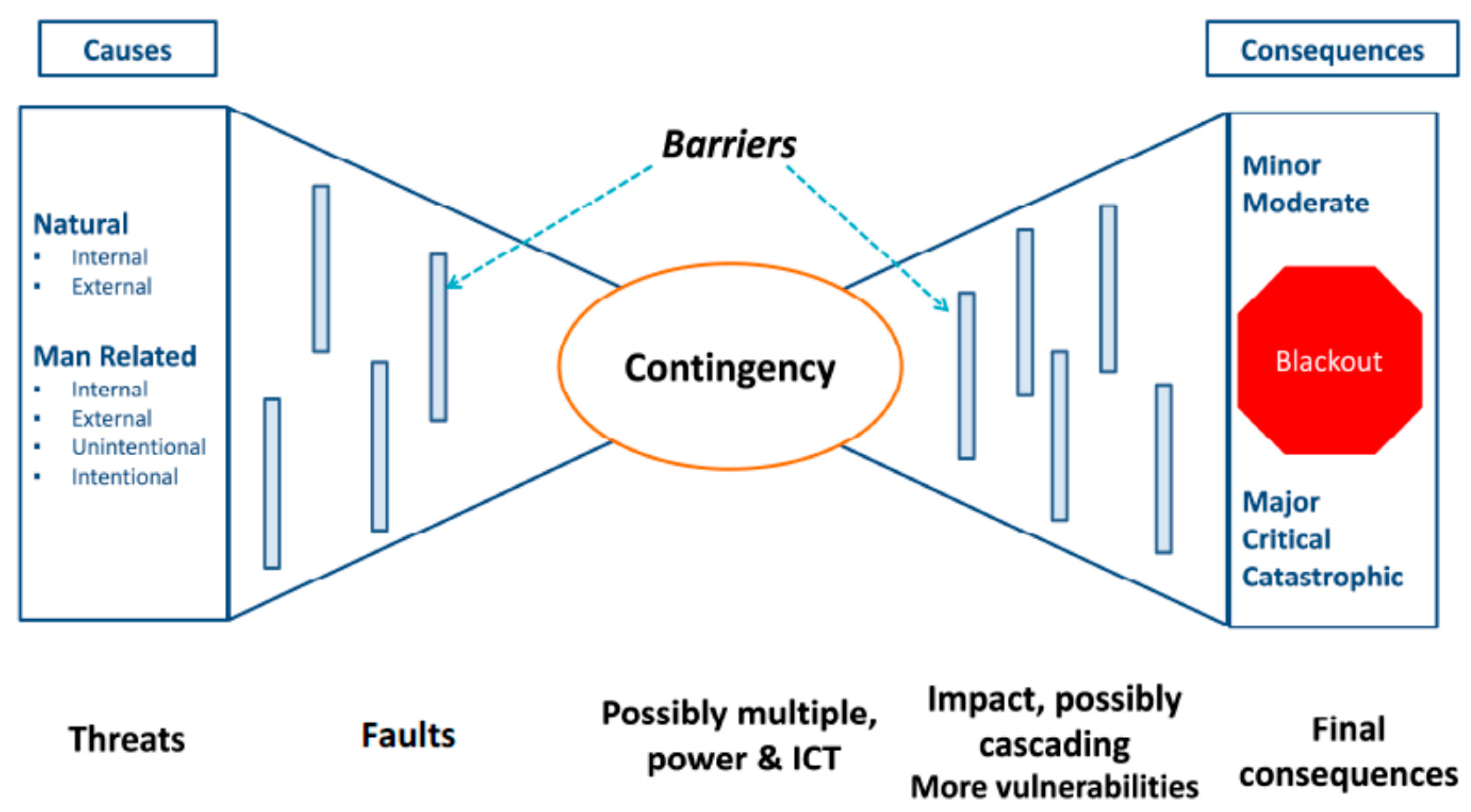

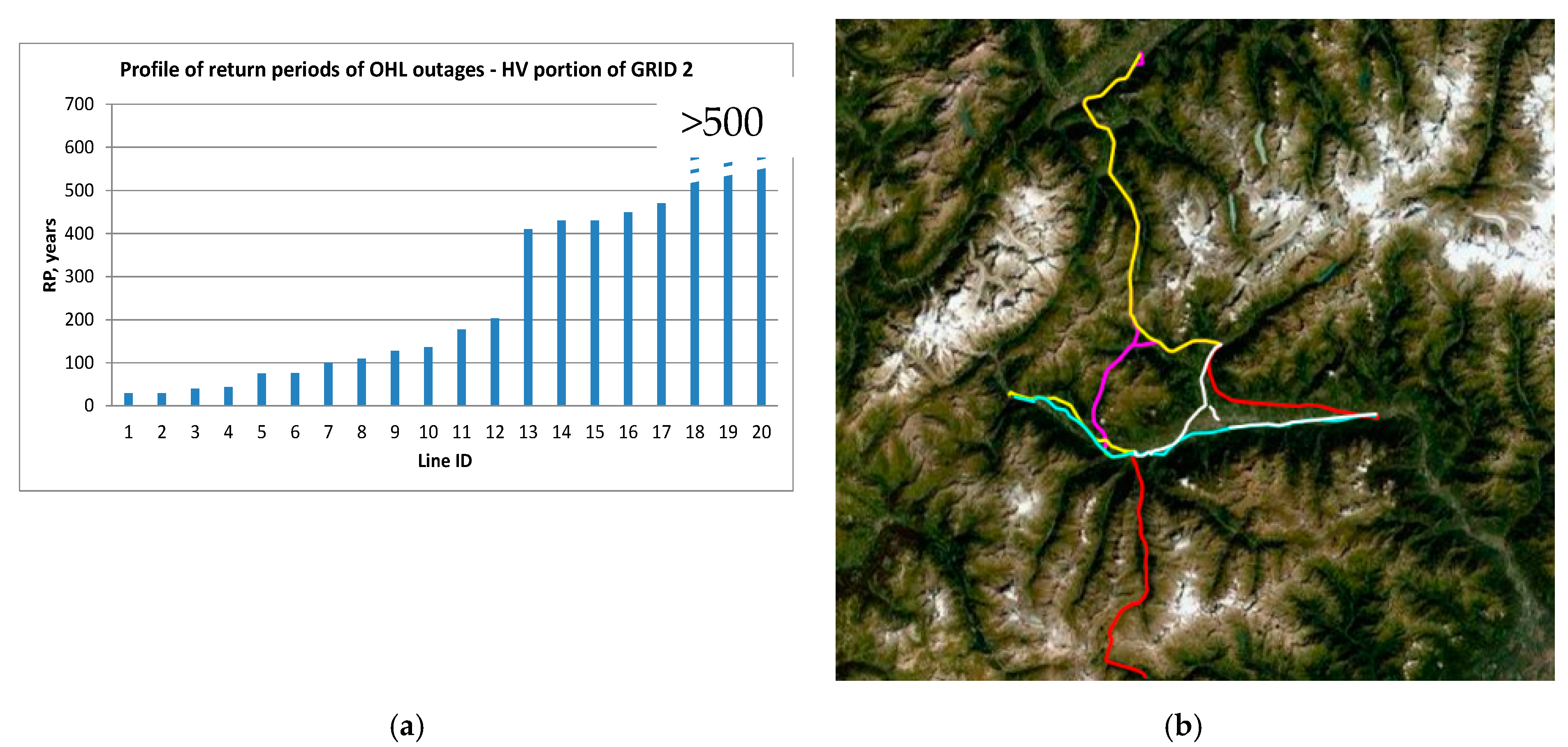



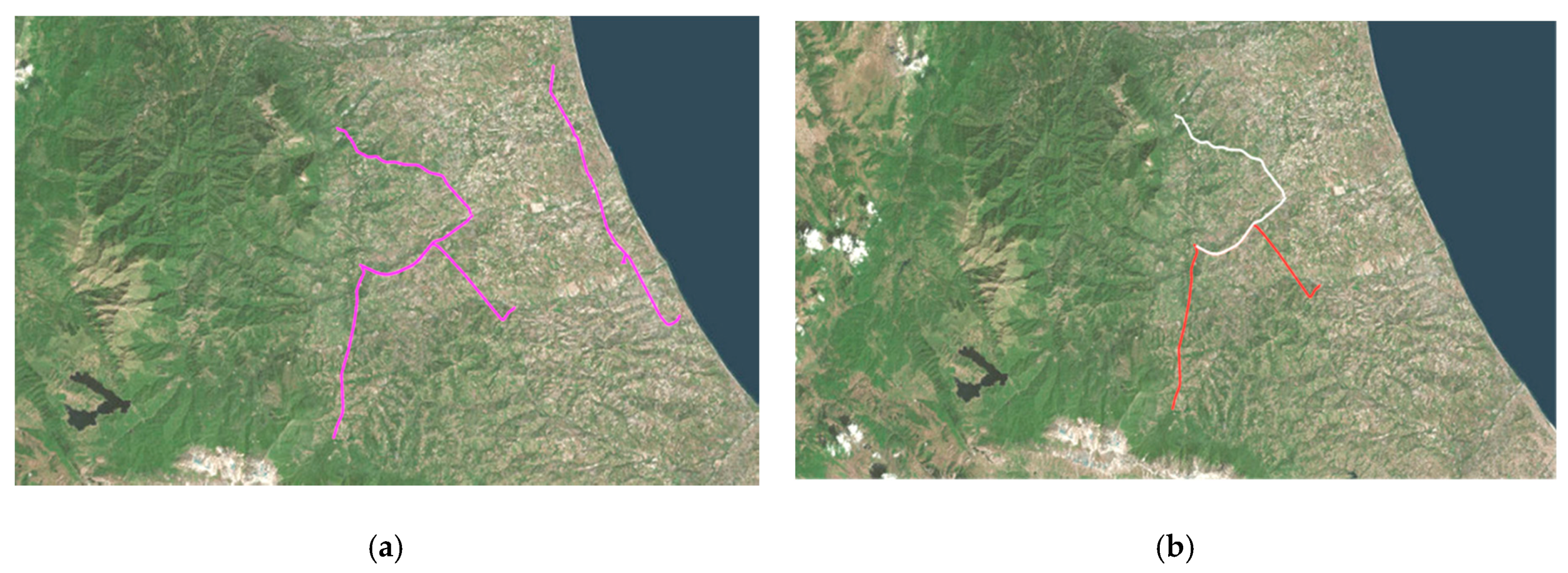
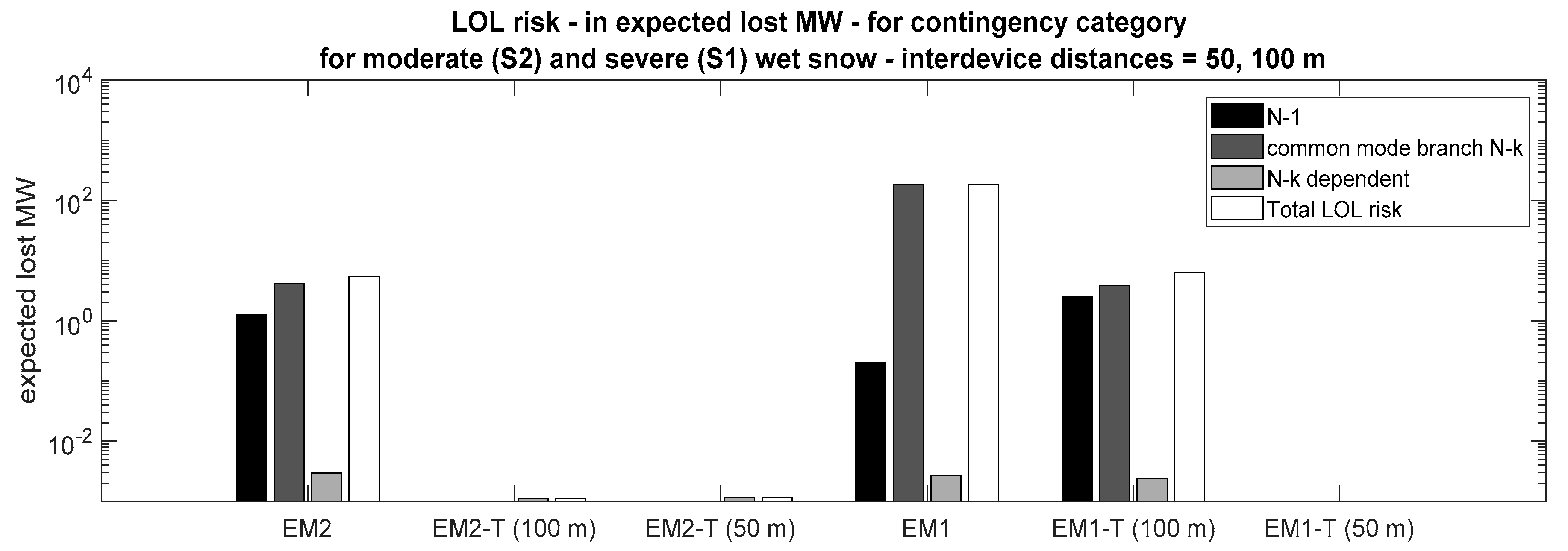


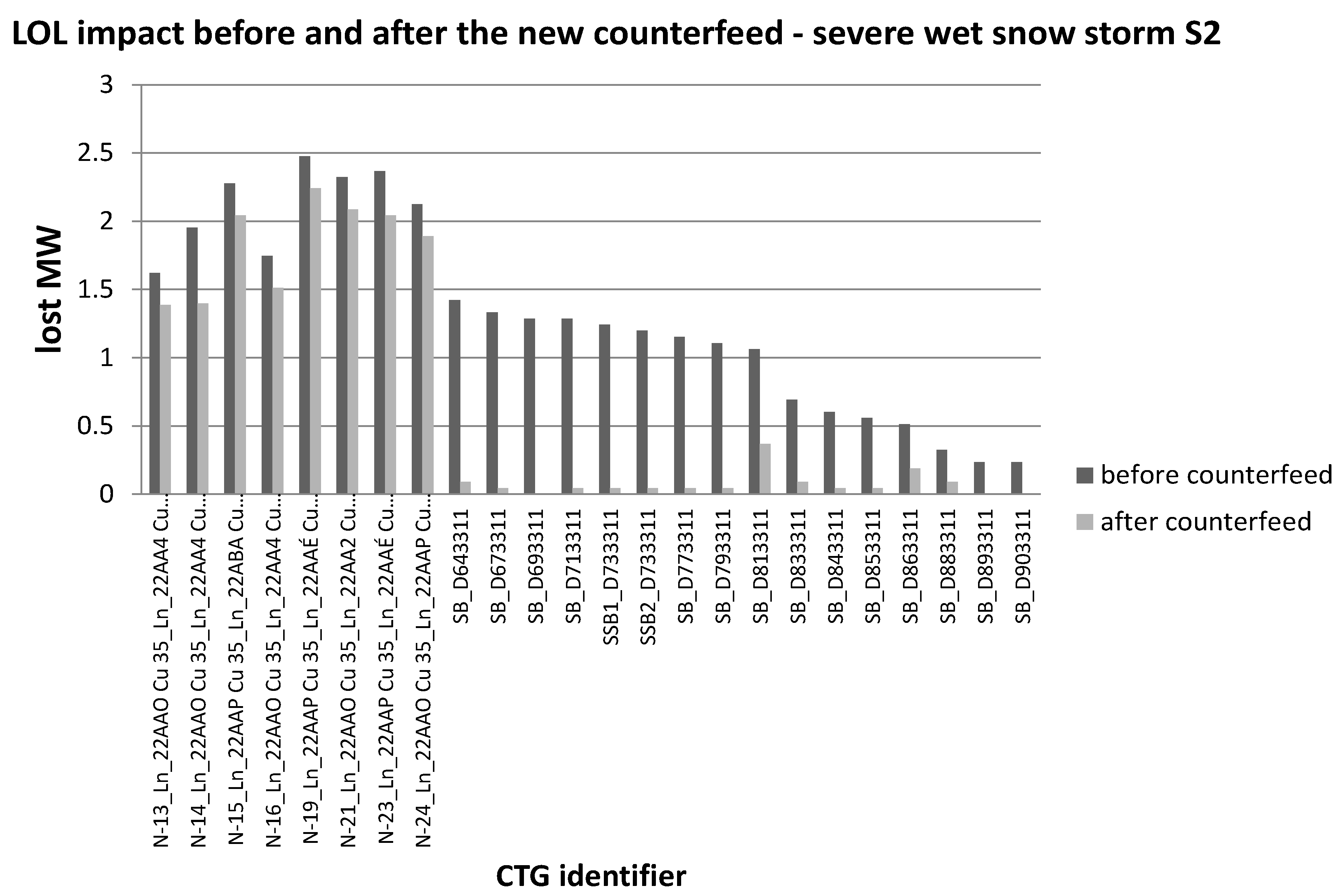
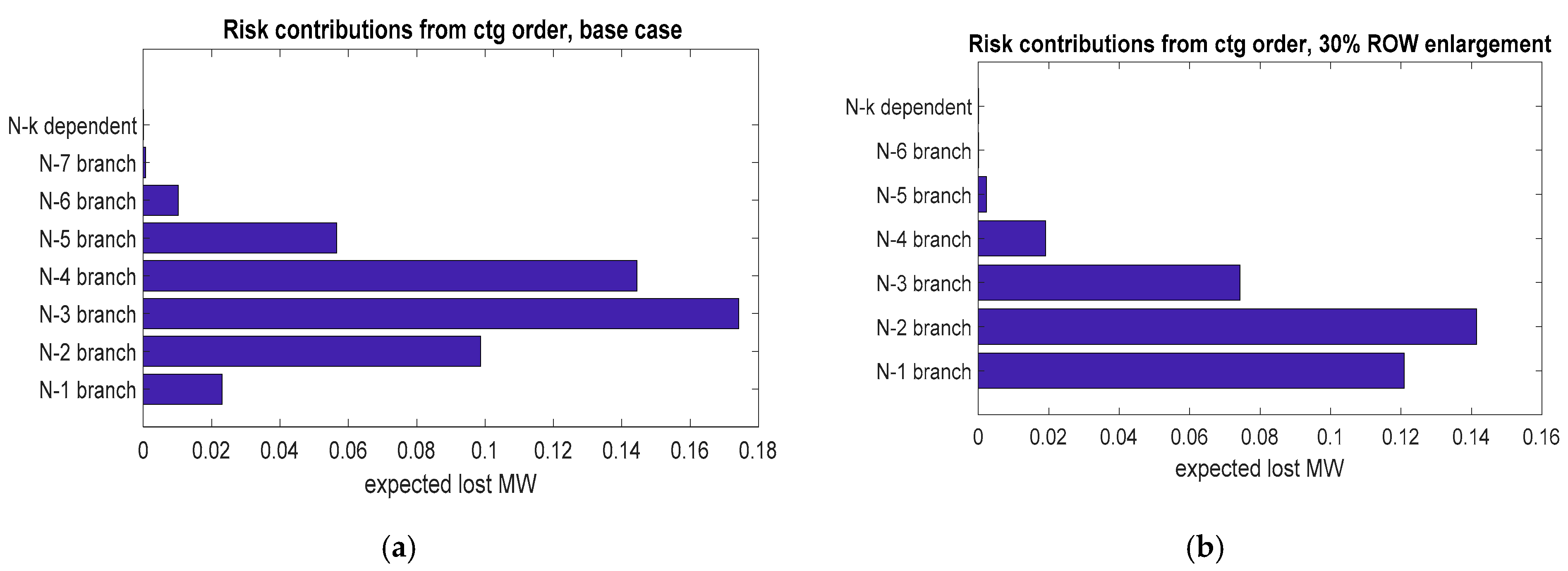
| Threats | Faults | Contingencies | Impacts | |
|---|---|---|---|---|
| Anticipation | Weather prediction and event monitoring and alarm systems. | Predictive DLR (Dynamic Line Rating). | Multiple contingencies and their probability. | Loss of load. Branch overloading. Under/Overvoltages. |
| Preparation | Real time DLR Monitoring of transformers temperature Monitoring of leakage currents. | Wide area monitoring functions (WAMS) in SCADA. | WAMS for higher situational awareness. | |
| Absorption | Dispatch of active and reactive powers for anti-icing and de-icing. | Controlling the clearance from ground by decreasing line currents, to avoid flashover. Increasing the line sag to increase the admissible snow sleeve load. Operating the grid components at lower voltages to avoid insulator flashover. Reduction of power imbalances among areas to decrease the vulnerability of grid corridors. | Substation reconfiguration aimed at reducing the probability of multiple contingencies. Fast reclosure. Slow reclosure. Adaptive protection systems for multiple contingencies with fast configuration changes. | Post contingency reconfigurations to decrease operational risk.Coordinated voltage and frequency control. Counterfeeding also between different voltage levels. Redispatching. Adaptive SPS (Special Protection Systems). Adaptive controlled islanding based on predictions and preventive redispatching. Response based and event based defense plans. |
| Sustainment of critical system operations | - | - | - | Deployment of additional components (for example, mobile generator), systems (e.g., uninterruptible power supplies). |
| Rapid recovery | - | - | - | Optimal scheduling of maintenance teams. Enhance communications and connections with Civil Protection and other public authorities. |
| Adaptation | Upgrades of prevention barriers and maintenance procedures. | Upgrades of prevention barriers and maintenance procedures. | Upgrades of operational procedures and regimes. | Upgrades of operational and maintenance procedures. |
| Case | Grid Under Test | Affected Area | Mode | Threat | Measures |
|---|---|---|---|---|---|
| PL1 | Base case GRID 2 | HV portion | PL | Wet snow | Computation of return periods of outages |
| PL2 | Base case GRID 1 | HV grid of Sardinia | PL | Pollution | Comparison of return periods of outages with different insulator vulnerabilities |
| OP1 | Base case GRID 1 adapted to Feb 2015 conditions | North of Italy | OP | Wet snow | Contingency forecasting |
| EM2 | Base case GRID 1 + moderate wet snow event S2 | Central Italy | EM | Wet snow | Resilience analysis |
| EM2-T | Base case GRID 1 + moderate wet snow storm | Central Italy | EM | Wet snow | Anti-torsional devices with interdistances 50 m/100 m |
| EM2-C | Base case GRID 1 + moderate wet snow storm S2 | Central Italy | EM | Wet snow | Hydrophobic coatings with different delays 3/6/9 h |
| EM2-A | Base case GRID 1 + moderate wet snow storm S2 | Central Italy | EM | Wet snow | Generation redispatching |
| EM1 | Base case GRID 1 + severe wet snow storm S1 | Central Italy | EM | Wet snow | Resilience indicators for sensitivity analyses |
| EM1-T | Base case GRID 1 + severe wet snow storm S1 | Central Italy | EM | Wet snow | Anti-torsional devices with interdistance 50/100 m |
| EM1-C | Base case GRID 1 + severe wet snow storm S1 | Central Italy | EM | Wet snow | Hydrophobic coatings with different delays 6/9/3 h |
| EM1-A | Base case GRID 1 + severe wet snow storm S1 | Central Italy | EM | Wet snow | Redispatching of conventional generators |
| EM3 | Base case GRID 2 + severe wet snow storm S1 | T&D system | EM | Wet snow | Resilience indicators for sensitivity analyses |
| EM4 | Base case GRID 2, moderate wet snow storm S2 | T&D system | EM | Wet snow | Resilience indicators for sensitivity analyses |
| EM3-A1 | Base case GRID 2 + severe wet snow storm S1 | T&D system | EM | Wet snow | Optimal reconfiguration for counterfeeds |
| EM4-A2 | Base case GRID 2 moderate wet snow storm S1 currents | T&D system | EM | Wet snow | OPF based active measure |
| EM3-P1 | Base case GRID 2 + severe wet snow storm S1 | T&D system | EM | Wet snow | Construction of a new counterfeed |
| EM4-P2 | Base case GRID 2 + moderate wet snow storm S1 | T&D system | EM | Wet snow | Reconductoring of small section branches |
| EM5 | Base case GRID 2 | T&D system | EM | Tree fall | Resilience indicators for sensitivity analyses |
| EM5-P1 | Base case GRID 2 | T&D system | EM | Tree fall | Enlargement of ROW |
| EM5-P2 | Base case GRID 2 | T&D system | EM | Tree fall | Trimming of tree height |
| Hazard Parameter | Measurement Unit | Severe Storm (S1) | Moderate Storm (S2) |
|---|---|---|---|
| Peak wind speeds | m/s | 10–15 | 10–5 |
| Precipitation rate | mm/h | 2 | 1 |
| Initial precipitation level | mm | 20 | 30 |
| Air temperature range | °C | −0.6 (for S1m scenarios) 1 °C (for S1p scenarios) | −0.6 |
| Hour Ahead | Branch ID | Failure Probability |
|---|---|---|
| 8 | POTF411–VEGF411 | 1.221 × 10−15 |
| 10 | POTF411–VEGF411 | 0.868 |
| POTF411–PTAF411 | 0.308 | |
| 15 | POTF411–VEGF411 | >0.9 |
| BRBF41a–FZAF411 | >0.9 | |
| POTF411–PTAF411 | >0.9 | |
| SASF411–SVKF411 | >0.9 | |
| MZBF411–SASF411 | 0.865 | |
| MZAF411–SASF411 | 0.815 |
| Case EM1: Severe Wet Snow Storm | Case EM2: Moderate Wet Snow Storm | ||
|---|---|---|---|
| Comp ID | Failure prob (/10 min) | Comp ID | Failure prob (/10 min) |
| ALDR411–GIUR411 | >0.90 | CLTR411–TRMR411 | 0.768 |
| GIUR411–ROSR411 | >0.90 | TRMR411–IGSR411 | 0.396 |
| TRMR411–IGSR411 | >0.90 | TRMR411–TRWR411 | 0.199 |
| CVDR411–TRWR411 | >0.90 | CVDR411–TRWR411 | 0.167 |
| TRMR411–TRWR411 | >0.90 | ||
| PINR411–ROSR411 | >0.90 | ||
| CLTR411–TRMR411 | >0.90 | ||
| Severe Storm, Inter-Device Distance = 50 m, EM1-T (50 m) | Severe Storm, Inter-Device Distance = 100 m, EM1-T (100 m) | ||
| Comp ID | Failure prob (/10 min) | Comp ID | Failure prob (/10 min) |
| VLLR111–VLVR111 | 1.88 × 10−2 | TRMR411–IGSR411 | 6.90 × 10−1 |
| GIUR411–ROSR411 | 4.53 × 10−1 | ||
| CLTR411–TRMR411 | 9.20 × 10−2 | ||
| CVDR411–TRWR411 | 9.05 × 10−2 | ||
| Moderate Storm, Inter-Device Distance = 50 m, EM2-T (50 m) | Moderate Storm, Inter-Device Distance = 100 m, EM2-T (100 m) | ||
| Comp ID | Failure prob (/10 min) | Comp ID | Failure prob (/10 min) |
| GIUR411–ROSR411 | 1.60 × 10−1 | GIUR411–ROSR411 | 1.60 × 10−1 |
| CLTR411–TRMR411 | 1.28 × 10−2 | ||
| Severe Storm—EM1-A | |||
| Branch ID | Initial Current, A | Final Current, A | Anti-Icing Current Requirement, A |
| VLVR–TERR | 345 | 920.7 | 1990 |
| MONR–VLLR | 89 | 467.9 | 582 |
| PRVR–SGIR | 54 | 144.5 | 663 |
| Moderate Storm—EM2-A | |||
| Branch ID | Initial Current, A | Final Current, A | Anti-Icing Current Requirement, A |
| PR2R–SGIR | 38 | 301.1 | 300.1 |
| PRVR–SGIR | 54 | 132.0 | 300.1 |
| State | MV | Percentage of Restored Load (%) | plosses, MW |
|---|---|---|---|
| 001 | 0.9951 | 66.67 | 0.0119 |
| 010 | 0.9987 | 48.30 | 0.0087 |
| 100 | 0.997 | 81.63 | 0.0125 |
| 011 | 0.9951 | 66.67 | 0.0119 |
| 101 | 0.9951 | 100 | 0.0156 |
| 110 | 0.9975 | 81.63 | 0.0109 |
| Minimum Current Value (A) | #53–#57 Active Power (kW) | #53–#57 Reactive Power (kVar) | #57 Voltage (p.u.) | PS MV Busbar Voltage at Primary Substation |
|---|---|---|---|---|
| 0 | −282 | −126 | 0.968 | 0.965 |
| 25 | 27 | −701 | 0.964 | 0.961 |
| 70 | 1827 | −116 | 1.010 | 0.990 |
© 2020 by the authors. Licensee MDPI, Basel, Switzerland. This article is an open access article distributed under the terms and conditions of the Creative Commons Attribution (CC BY) license (http://creativecommons.org/licenses/by/4.0/).
Share and Cite
Ciapessoni, E.; Cirio, D.; Pitto, A.; Sforna, M. Quantification of the Benefits for Power System of Resilience Boosting Measures. Appl. Sci. 2020, 10, 5402. https://doi.org/10.3390/app10165402
Ciapessoni E, Cirio D, Pitto A, Sforna M. Quantification of the Benefits for Power System of Resilience Boosting Measures. Applied Sciences. 2020; 10(16):5402. https://doi.org/10.3390/app10165402
Chicago/Turabian StyleCiapessoni, Emanuele, Diego Cirio, Andrea Pitto, and Marino Sforna. 2020. "Quantification of the Benefits for Power System of Resilience Boosting Measures" Applied Sciences 10, no. 16: 5402. https://doi.org/10.3390/app10165402
APA StyleCiapessoni, E., Cirio, D., Pitto, A., & Sforna, M. (2020). Quantification of the Benefits for Power System of Resilience Boosting Measures. Applied Sciences, 10(16), 5402. https://doi.org/10.3390/app10165402







